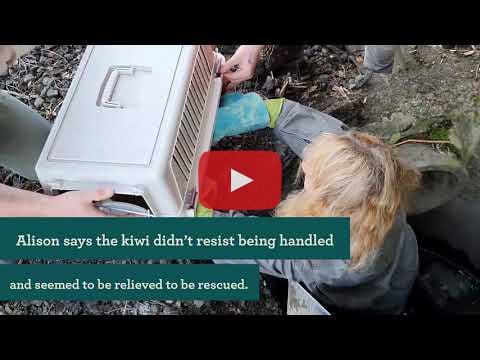No images? Click here
See nature through new eyes
Conservation Week 2020 encouraged everyone to enjoy a fresh perspective on nature - to see nature through new eyes.
"This is an opportunity for people to take time to immerse themselves in nature and reconnect with it. Papatūānuku’s wellbeing is our wellbeing. Take a little time in nature for your wellbeing, and if you can, give a little back to nature for its wellbeing." - Lou Sanson.
You can engage with Conservation Week activities online or by exploring your own backyard.
10 Questions about tahr
You might have seen Himalayan tahr in the news recently. You might also have been wondering how you’ve gone your entire life without knowing exactly what a tahr is.
Well, wonder no more. Here are 10 of the most asked questions about tahr.
Image: DOC
Sounds of Science - new podcast episode
Our latest episode is a supercut of our favourite moments from the past ten episodes. Lichens, bats, kākāpō sperm helmets (we couldn’t make this up), GPS poo patches and more – this episode is full of stories from all of our previous guests.
Recreation
Nature is good for us
You can love nature and not go camping, tramping or fishing.
DOC Communications Advisor Jeff Neems shares how his non-outdoorsy family have made the most of a stroll in nature for their wellbeing.
History of Hokitika Gorge
First used by Māori as they journeyed over the Southern Alps, the Hokitika Gorge has become one of the top must-see scenic attractions on the West Coast.
Recent upgrades (a new bridge and loop track) have elevated it to world class standards, but for such a popular destination, little is known of its history.
Backcountry huts to be restored
The Minister of Conservation announced a $2 million expansion of the Backcountry Trust’s programme to repair and maintain huts, tracks and bridges in some of New Zealand’s more remote places as part of the Jobs for Nature programme.
The Backcountry Trust has a long-term partnership with DOC to help maintain our nationwide network of backcountry tracks and huts.
Get involved
Experiencing penguins in the Antipodes
You can experience a virtual walk in a DOC scientist's footsteps to get up close with native penguins.
DOC Technical Advisor Dave Houston takes us behind-the-scenes of what it’s like working with penguins on the Antipodes.
Image: Dave Houston | DOC
Auckland trampers’ efforts boost kōkako numbers
Two groups of Auckland trampers have become key to the growth of the kōkako population in Pureora Forest.
"The reasons we volunteer are using our outdoor skills and gear for a worthwhile cause, enjoying the bush and birdlife, a chance to hear and see kōkako and the camaraderie of being with like-minded people” - Colleen Grayling
Community conservation projects to get extra support
The Minister of Conservation recently announced that 116 community conservation projects have been granted $5.44 million from DOC’s Community Fund/Pūtea Tautiaki Hapori.
The range of projects funded this year highlights the amazing work of volunteers and groups all over New Zealand.
Image: Sabine Bernert | ©
Our work
High flying help for our most endangered bird
Before the Auckland region went into Alert Level 3, the New Zealand Defence Force swooped in to help our rangers and the fairy tern/tara iti.
They supported the creation of man-made shell nesting sites north of Auckland.
Rakitū Island declared latest predator free island
“I’m delighted to announce that with rats now gone, Rakitū is officially predator free. This is a major milestone because Rakitū is the last DOC administered island in the Hauraki Gulf Marine Park to be made pest-free” - Minister of Conservation Eugenie Sage.
Predator Free 2050 will require some serious innovation
We need to eradicate rats, possums and stoats from Aotearoa by 2050. It'll take hard work, money, research, collaboration and commitment across generations of Kiwis.
PF2050 Programme Manager Brent Beaven is diving into the most exciting bit of this big goal - innovation.
Nature
Ruahine Whio Protector
Photographer Anthony Behrens had a particularly challenging weekend trying to photograph whio in the Ruahine Ranges.
From wayward tramping kilts, bloody knees to camera gear mishaps - it was quite the adventure.
Long road to recovery for kiwi rescued from culvert
For a lucky kiwi trapped in a culvert, his heroes came in the form of two roading inspectors and DOC ranger Alison Evan.
The kiwi was transported to Massey University's Wildbase Hospital, where staff commenced immediate treatment to keep it alive.
Video: DOC
Wild kakī population boosted
Classes from Twizel Area, Arowhenua and Tekapo schools helped release 104 juvenile kakī/black stilts into the wild in the Mackenzie Basin.
These birds are the world's rarest wading bird and were released as part of the ongoing Kakī Recovery Programme.
Image: Dean Nelson | DOC
Image: Richard Rossiter | DOC
Photo of the month
We’ve been monitoring birds in the lower Heaphy Valley in Kahurangi National Park since 2015 and are happy to share that results show a trend of nine native bird species increasing in number.
This includes species such as korimako/bellbird, pīwakawaka/fantail, riroriro/grey warbler, kākāriki/parakeet, toutouwai/robin, tauhou/silvereye, miromiro/tomtit, tūī and weka.
We’ve increased the frequency of predator control in the Heaphy valley, with annual aerial 1080 predator control to suppress rats. Further monitoring is needed, but so far results are very positive.
















